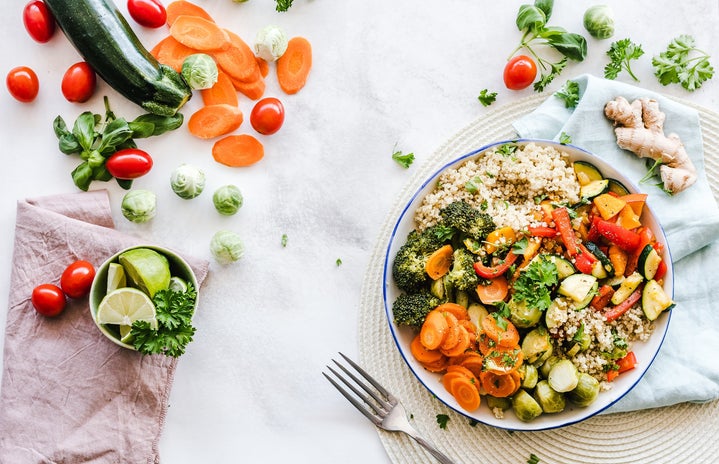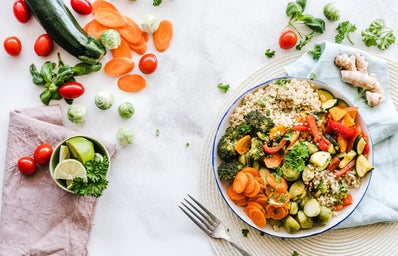We often don’t realize just how much our food choices affect the environment. Farming is one of the leading causes of greenhouse gas emissions, water use, and land destruction. However, there are certain categories of food that are much less destructive to the environment. Here are some easy ways you can adjust your eating habits to be more sustainable without having to radically change your diet.
- Buy organic
-
“Organic” means the food is grown with less chemicals, preservatives, and pesticides, which are not only harmful to your long term health, but to the environment as well. Additionally, organic farming practices decrease pollution, conserve water, reduce soil erosion, improve soil fertility, and use less energy overall. By buying more organic foods, you are helping to promote better and more sustainable farming practices that are often healthier for your body as well.
- Buy Fair Trade
-
In order to sell fair trade products, farmers have to follow many regulations such as improving the soil and water quality, avoiding the use of harmful chemicals, and protecting biodiversity. In fact, many fairtrade products are also organic. Fair trade also prohibits cutting down forests in order to plant more crops, which is especially a problem in the coffee and cocoa industries. This makes fair trade chocolate and coffee attractive choices for consumers.
- Reduce food waste
-
This is pretty intuitive, but it can often be more difficult in practice that we think. It is easy to overeat, cook a little too much food, not want to save restaurant meals as leftovers, or forget about those old grapes in the fridge that now have mold on them. But by only cooking/taking/ordering what you know you can eat, or even donating food in your cupboard to a local food bank, will go a long way into reducing your overall impact on the environment. Composting organic material or old foods that are no longer edible is also a really great option.
- Dine in rather than wasting to go containers
-
An easy strategy that is often overlooked especially during COVID times is choosing to eat at a restaurant/dining hall rather than getting disposable to-go containers or silverware. I know this isn’t always possible, but it is good to be aware of the potential amount of waste takeout containers and utensils can create.
- Reuse!
-
If dine-in is not an option, it still helps to bring your own utensils rather than taking a new one every time you get take-out. For instance, try keeping some utensils in your backpack or purse so you don’t need to waste additional ones when you get meals on the go. It’s usually easier than we think to supply our own reusable forks and knives rather than opting for fresh plastic each time. Additionally, always having your favorite reusable water bottle with you will help to keep you hydrated, save you from spending money on water every time you need some, and help the planet by reducing the pollution caused by plastic water bottles.
- Choose white over red meat whenever possible.
-
Not all meat is created equal. White meat—including chicken, turkey, and fish—is much less harmful than cow or even pork meat. Poultry and seafood require less land and water to grow, and the production of these meats adds much less nitrogen and carbon to the environment than the larger, red meat animals such as cows, pigs, lamb, or deer. Additionally, in my experience, substituting the occasional beef with chicken is a very doable change.
- Meatless Mondays
-
Another beneficial and simple strategy would be to choose plant-based options over meat, even if it is just once per week. Remember that you don’t have to go completely vegetarian or vegan to help decrease the impact of meat production on the environment. The meat industry is one of the largest contributors to water waste, greenhouse gasses, nitrogen, and land destruction, so it is important for us to be aware of the impact our food choices have on the planet. Simply being conscious about reducing our consumption of animal products and choosing vegetarian foods when possible is helpful. There are countless non-animal sources of protein, and it may even be fun to try new foods you might have otherwise ignored. Plus, for all my fellow Wahoos, I cannot recommend enough Asado’s cauliflower wings!
- Dairy-free > regular milk
-
Our national dependence on cows is a substantial environmental problem. This involves not only those used for meat, but also dairy cows. If you don’t mind the change in flavor (in fact, many people even prefer the taste of alternative milks), switching to plant-based milk is pretty doable. There seems to be infinite types of dairy-free milks available, although some of the most popular are almond, oat, coconut, and soy milk. Hemp, cashew, and rice milk are also options if you can find them. Like meats, not every plant-based milk is created equal (for instance, almonds require a tremendous amount of water to grow), but across the board, they all perform significantly better than dairy in terms of carbon emissions and land/water use. Moreover, vegan milks often last longer in the fridge, which reduces the chance of having to create food waste by getting rid of expired milk. Try almond milk creamer in your coffee, pour rice milk in your cereal, bake with coconut milk, or (might I suggest) even jump on the bandwagon to try Starbucks’ new Brown Sugar Oat Milk Shaken Espresso.

